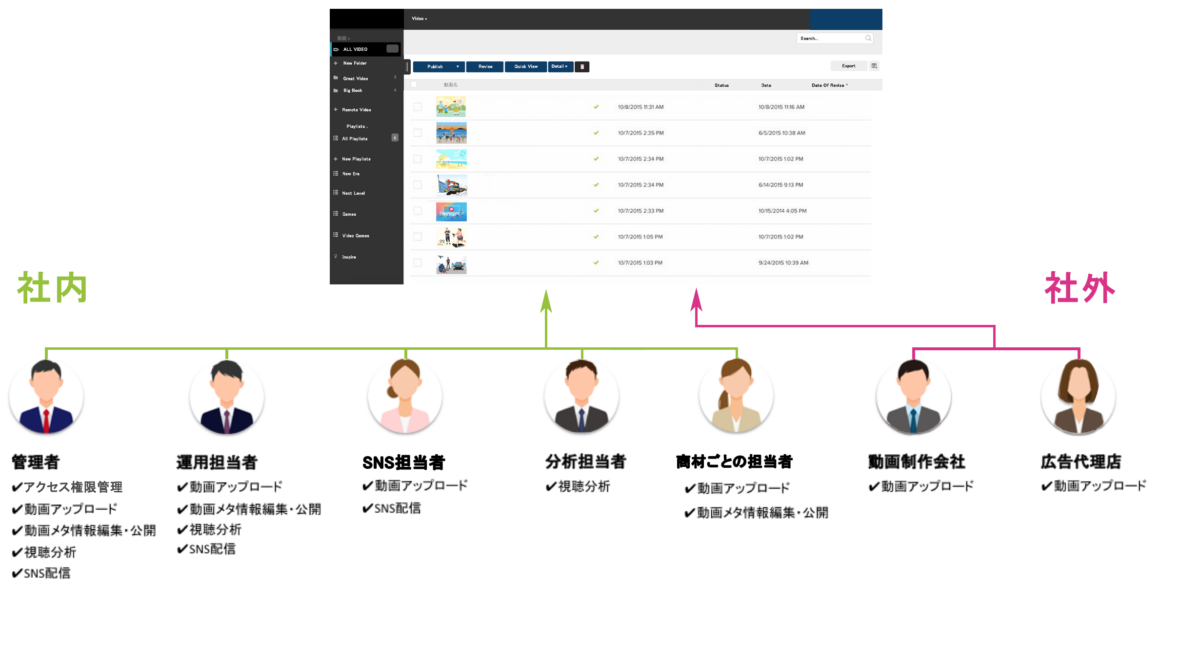When a company introduces a video distribution platform, it is necessary to design how the system will be operated. In this blog, we will explain what the concept of operational design is, why it is important, and how to decide on the design items related to video management and distribution, including specific design items. ### **Table of Contents** [**①What is operational design?**](#example1) [**②Operational design required for video management and distribution**](#example2) [**③Design items**](#example3) ****①What is operational design? **** —————- Operational design refers to the **creation of a framework for operational tasks**, taking into account the situations and issues that are likely to arise. Specifically, it involves compiling the necessary information for each person in charge of the content, rules and processes of the work that is carried out on a daily, regular or irregular basis. Operational design provides an opportunity to organize and review workflows, and has the benefit of **simplifying, streamlining and optimizing** the overall work, leading to a reduction in the number of man-hours spent on simple tasks and human error. In addition, by making things explicit, you can **avoid making operations dependent on specific individuals or turning them into a black box**. ****②Operational design required for video management and distribution**** —————————- Now let’s take a look at the operational design required for video management and distribution. In this blog, we will assume that the **marketing department is in charge of the video distribution platform** and is trying to achieve the following items * Transferring video files to external and internal parties * Managing your company’s video assets * Distributing videos to your company’s website * Distributing videos to SNS * Analyzing video views In a separate blog post, “4 Steps to Getting the Most Out of Your Video Platform” (https://www. www.brightcove.com/en/blog/2019/12/video-platform-4steps), we recommend checking the types of videos you have in-house, the people involved both inside and outside the company, and the current and ideal workflows for video distribution, and using these kinds of items as a reference will make it easier to design. Furthermore, after considering these points, imagine creating a video management and distribution operation manual, and design in detail who, when, where, and how it will be used. Clearly organizing the target audience and response methods is the first step towards simplifying, streamlining and optimizing the overall operation of the video distribution platform. * **Target audience**: Who will use the video distribution platform? * **Response methods**: When performing tasks such as uploading videos or distributing videos to SNS, what procedures will be used and when? * **Operation manual**: If the above items are compiled into an operation manual, it will be easier to prevent the operation of the video distribution platform from becoming personalized or a black box. ****③Design Items**** ————- From here, we will give examples of the items that should be considered when designing the system. In reality, the structure and scope of implementation will differ from company to company. Please **arrange the items according to your company’s situation**, as you may not only be introducing a new video distribution platform, but also replacing the platform you are currently using. **1. Purpose of Introduction, Requirements Definition** First, **clarify the purpose of introducing the video distribution platform**, and write down the details of what you want to achieve by introducing the video distribution platform. By aligning the perceptions of all those involved regarding the assumptions, you can avoid inefficiencies caused by miscommunication. * **Purpose of introducing a video distribution platform**: To appropriately manage video assets within the company, share videos, distribute videos to the company website and SNS, and analyze video viewing data. Next, let’s move on to the **requirements definition**. List the system requirements. For example, this could include things like operational stability, multi-device compatibility, information leak prevention, and access analysis functions. **2. Workflow and Work Content** Next, in order to clarify the outline of the work that will be achieved through the video distribution platform, let’s **list out the specific work that will be done** and organize how these tasks will be carried out. By covering all the possible work, there is a possibility that you will be able to discover points where you can simplify, streamline, and optimize. * Video file transfer (sharing) * Management and listing of company video assets * Video distribution and updating on company website * Video distribution and updating on company SNS (Facebook, YouTube, etc.) * Video viewing data acquisition and analysis (data analysis linked to other tools) **3. System management** The following are the **recommended items for management** regarding the video distribution platform itself. These are not items that require regular work, like the videos themselves, but rather items that require work only when setting up initially or making irregular changes. * Access privileges for each user * Type of video player (player that displays a single video, player that displays multiple videos side by side, etc.) * Settings for systems that can be linked (access analysis tools such as Adobe Analytics and Google Analytics, * marketing automation tools such as Marketo and Oracle Eloqua, plugins required when linking with CMS such as WordPress and Drupal, etc.) * Contact system in the event of a failure **4. System Operation Structure** Let’s **define a team structure** for actually operating the video distribution platform. It is a good idea to organize users and summarize them in a clear way using diagrams and charts. * **Users of the video distribution platform** **- Internal staff {each staff member’s location (overseas, domestic) and department}** * Administrators * Operation staff * SNS staff * Analysis staff * Staff in charge of each product **- External staff** * Video production companies * Advertising agencies

**5. Operation Schedule** **Let’s manage the schedule for each task**. By carrying out tasks in line with the schedule, you can prevent omissions and carry out tasks efficiently. * Daily, monthly, etc. work schedules (data acquisition for viewing analysis, viewing analysis, etc.) * Regular and irregular work content (video uploads, video distribution to SNS, etc.) **6. Data management** **Organize the items to be managed among the data handled by the video distribution platform**. The following 10 items are recommended for management, but for more details, please refer to the separate article “10 Points to Keep in Mind When Managing Videos” (https://docs.google.com/document/d/1RTYNgDRgYihT32-HjGjTMe-eAL-kL_bAXmNpnyso_yU/edit?usp=sharing) (1) Operational structure, access permissions (2) Category (3) Title (4) Thumbnail (5) Subtitles (6) Distribution range (7) Publication settings (8) File size (9) Creator, publisher, updater and date (10) Viewing data By carrying out operational design at the earliest possible stage, it is possible to simplify, streamline and optimize the entire workflow. We hope you will use this article as a reference when designing your video distribution platform and make the most of video.




